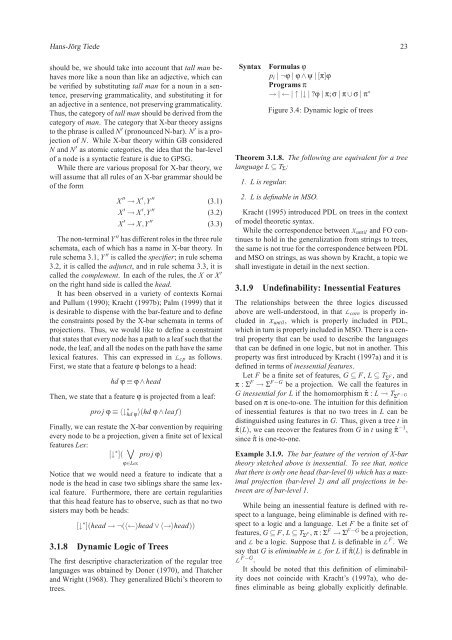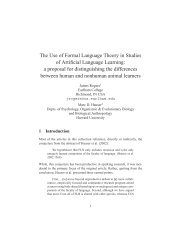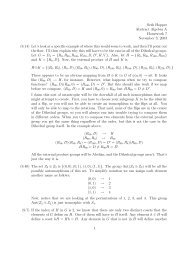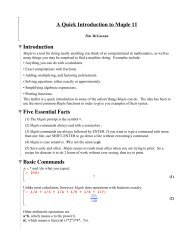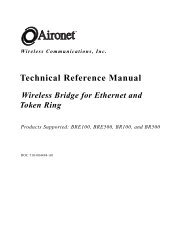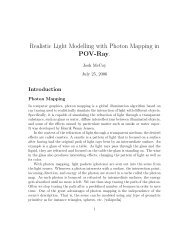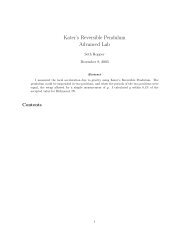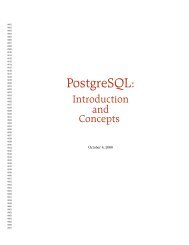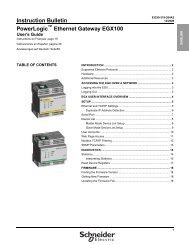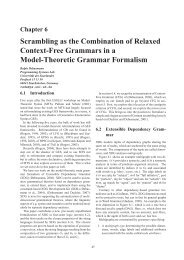Model-Theoretic Syntax at 10 - Earlham Computer Science ...
Model-Theoretic Syntax at 10 - Earlham Computer Science ...
Model-Theoretic Syntax at 10 - Earlham Computer Science ...
Create successful ePaper yourself
Turn your PDF publications into a flip-book with our unique Google optimized e-Paper software.
Hans-Jörg Tiede 23<br />
should be, we should take into account th<strong>at</strong> tall man behaves<br />
more like a noun than like an adjective, which can<br />
be verified by substituting tall man for a noun in a sentence,<br />
preserving gramm<strong>at</strong>icality, and substituting it for<br />
an adjective in a sentence, not preserving gramm<strong>at</strong>icality.<br />
Thus, the c<strong>at</strong>egory of tall man should be derived from the<br />
c<strong>at</strong>egory of man. The c<strong>at</strong>egory th<strong>at</strong> X-bar theory assigns<br />
to the phrase is called N ′ (pronounced N-bar). N ′ is a projection<br />
of N. While X-bar theory within GB considered<br />
N and N ′ as <strong>at</strong>omic c<strong>at</strong>egories, the idea th<strong>at</strong> the bar-level<br />
of a node is a syntactic fe<strong>at</strong>ure is due to GPSG.<br />
While there are various proposal for X-bar theory, we<br />
will assume th<strong>at</strong> all rules of an X-bar grammar should be<br />
of the form<br />
X ′′ → X ′ ,Y ′′ (3.1)<br />
X ′ → X ′ ,Y ′′ (3.2)<br />
X ′ → X,Y ′′ (3.3)<br />
The non-terminalY ′′ has different roles in the three rule<br />
schem<strong>at</strong>a, each of which has a name in X-bar theory. In<br />
rule schema 3.1, Y ′′ is called the specifier; in rule schema<br />
3.2, it is called the adjunct, and in rule schema 3.3, it is<br />
called the complement. In each of the rules, the X or X ′<br />
on the right hand side is called the head.<br />
It has been observed in a variety of contexts Kornai<br />
and Pullum (1990); Kracht (1997b); Palm (1999) th<strong>at</strong> it<br />
is desirable to dispense with the bar-fe<strong>at</strong>ure and to define<br />
the constraints posed by the X-bar schem<strong>at</strong>a in terms of<br />
projections. Thus, we would like to define a constraint<br />
th<strong>at</strong> st<strong>at</strong>es th<strong>at</strong> every node has a p<strong>at</strong>h to a leaf such th<strong>at</strong> the<br />
node, the leaf, and all the nodes on the p<strong>at</strong>h have the same<br />
lexical fe<strong>at</strong>ures. This can expressed inL cp as follows.<br />
First, we st<strong>at</strong>e th<strong>at</strong> a fe<strong>at</strong>ure ϕ belongs to a head:<br />
hd ϕ ≡ ϕ ∧ head<br />
Then, we st<strong>at</strong>e th<strong>at</strong> a fe<strong>at</strong>ure ϕ is projected from a leaf:<br />
pro j ϕ ≡ 〈↓ ∗ hd ϕ 〉(hd ϕ ∧ lea f)<br />
Finally, we can rest<strong>at</strong>e the X-bar convention by requiring<br />
every node to be a projection, given a finite set of lexical<br />
fe<strong>at</strong>ures Lex:<br />
[↓ ∗ ]( _<br />
pro j ϕ)<br />
ϕ∈Lex<br />
Notice th<strong>at</strong> we would need a fe<strong>at</strong>ure to indic<strong>at</strong>e th<strong>at</strong> a<br />
node is the head in case two siblings share the same lexical<br />
fe<strong>at</strong>ure. Furthermore, there are certain regularities<br />
th<strong>at</strong> this head fe<strong>at</strong>ure has to observe, such as th<strong>at</strong> no two<br />
sisters may both be heads:<br />
[↓ ∗ ](head → ¬(〈←〉head ∨ 〈→〉head))<br />
3.1.8 Dynamic Logic of Trees<br />
The first descriptive characteriz<strong>at</strong>ion of the regular tree<br />
languages was obtained by Doner (1970), and Th<strong>at</strong>cher<br />
and Wright (1968). They generalized Büchi’s theorem to<br />
trees.<br />
<strong>Syntax</strong><br />
Formulas ϕ<br />
p i | ¬ϕ | ϕ ∧ ψ | [π]ϕ<br />
Programs π<br />
→ | ← | ↑ |↓ | ϕ | π;σ | π ∪ σ | π ∗<br />
Figure 3.4: Dynamic logic of trees<br />
Theorem 3.1.8. The following are equivalent for a tree<br />
language L ⊆ T Σ :<br />
1. L is regular.<br />
2. L is definable in MSO.<br />
Kracht (1995) introduced PDL on trees in the context<br />
of model theoretic syntax.<br />
While the correspondence betweenX until and FO continues<br />
to hold in the generaliz<strong>at</strong>ion from strings to trees,<br />
the same is not true for the correspondence between PDL<br />
and MSO on strings, as was shown by Kracht, a topic we<br />
shall investig<strong>at</strong>e in detail in the next section.<br />
3.1.9 Undefinability: Inessential Fe<strong>at</strong>ures<br />
The rel<strong>at</strong>ionships between the three logics discussed<br />
above are well-understood, in th<strong>at</strong>L core is properly included<br />
inX until , which is properly included in PDL,<br />
which in turn is properly included in MSO. There is a central<br />
property th<strong>at</strong> can be used to describe the languages<br />
th<strong>at</strong> can be defined in one logic, but not in another. This<br />
property was first introduced by Kracht (1997a) and it is<br />
defined in terms of inessential fe<strong>at</strong>ures.<br />
Let F be a finite set of fe<strong>at</strong>ures, G ⊆ F, L ⊆ T Σ F , and<br />
π : Σ F → Σ F−G be a projection. We call the fe<strong>at</strong>ures in<br />
G inessential for L if the homomorphism ˆπ : L → T Σ F−G<br />
based on π is one-to-one. The intuition for this definition<br />
of inessential fe<strong>at</strong>ures is th<strong>at</strong> no two trees in L can be<br />
distinguished using fe<strong>at</strong>ures in G. Thus, given a tree t in<br />
ˆπ(L), we can recover the fe<strong>at</strong>ures from G in t using ˆπ −1 ,<br />
since ˆπ is one-to-one.<br />
Example 3.1.9. The bar fe<strong>at</strong>ure of the version of X-bar<br />
theory sketched above is inessential. To see th<strong>at</strong>, notice<br />
th<strong>at</strong> there is only one head (bar-level 0) which has a maximal<br />
projection (bar-level 2) and all projections in between<br />
are of bar-level 1.<br />
While being an inessential fe<strong>at</strong>ure is defined with respect<br />
to a language, being eliminable is defined with respect<br />
to a logic and a language. Let F be a finite set of<br />
fe<strong>at</strong>ures, G ⊆ F, L ⊆ T Σ F , π : Σ F → Σ F−G be a projection,<br />
andL be a logic. Suppose th<strong>at</strong> L is definable inL F . We<br />
say th<strong>at</strong> G is eliminable inL for L if ˆπ(L) is definable in<br />
L F−G .<br />
It should be noted th<strong>at</strong> this definition of eliminability<br />
does not coincide with Kracht’s (1997a), who defines<br />
eliminable as being globally explicitly definable.


